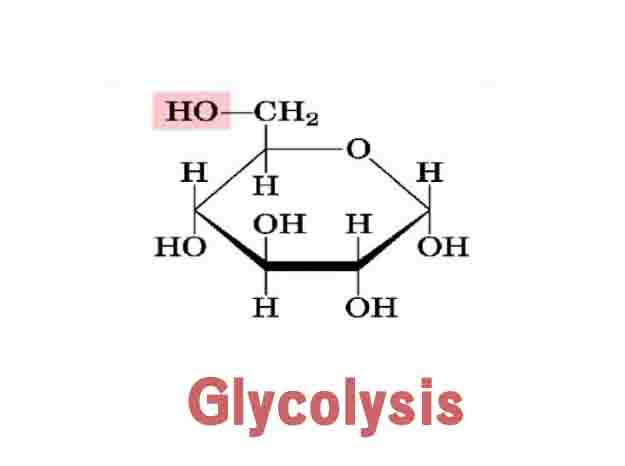Glycolysis is a 10 step process that releases energy from glucose and converts glucose into pyruvate. These reactions take place in the cytosol of cells and can happen in the presence or absence of oxygen.
During glycolysis, a single molecule of glucose is used to produce a net two molecules of pyruvate, two molecules of ATP, and two molecules of NADH. The pyruvate may then be used in aerobic respiration or, in the absence of oxygen, anaerobic respiration.
The 10 steps of glycolysis can be divided into two parts. These are the energy-requiring phase (steps 1 – 5) and the energy-releasing phase (steps 6 – 10).
What is Glycolysis?
Glycolysis (AKA the glycolytic pathway) is the metabolic process that releases energy from glucose. During glycolysis, a single molecule of glucose is split into two 3-carbon molecules, called pyruvates.
At the same time, energy is extracted from glucose and converted into ATP, which is then used to fuel other cellular processes.
Glycolysis takes place in the cytosol of cells, can happen with or without oxygen, and involves a series of 10 chemical reactions.
The 10 Steps of Glycolysis
There are 10 steps of glycolysis, each involving a different enzyme. Steps 1 – 5 make up the energy-requiring phase of glycolysis and use up two molecules of ATP. Steps 6 – 10 are the energy-releasing phase, which produces four molecules of ATP and two molecules of NADPH.
The net products of glycolysis are two molecules of pyruvate, two molecules are ATP, and two molecules of NADPH.
The Energy-Requiring Phase of Glycolysis
During the energy-requiring phase of glycolysis, two ATP molecules are used to split one molecule of glucose into two molecules of glyceraldehyde-3-phosphate.
Step 1
In the first step of glycolysis, a phosphate group is transferred from ATP to glucose, creating glucose-6-phosphate. This reaction is called phosphorylation and is catalyzed by the enzyme hexokinase. Step 1 of glycolysis uses one molecule of ATP.
Step 2
During step two of glycolysis, glucose-6-phosphate is converted into fructose-6-phosphate by the enzyme phosphoglucomutase. Fructose-6-phosphate is an isomer of glucose-6-phosphate.
Step 3
A second ATP molecule is used to phosphorylate fructose-6-phosphate, producing fructose-1,6-bisphosphate. This step is catalyzed by phosphofructokinase.
Step 4
The enzyme aldolase splits fructose-1,6-bisphosphate into two three-carbon sugars. These are dihydroxyacetone phosphate (DHAP) and glyceraldehyde-3-phosphate (GAP). These two sugars are isomers of one another.
Step 5
The DHAP from step 6 is rapidly converted into GAP by the enzyme triose-phosphate isomerase.
The Energy-Releasing Phase of Glycolysis
During the energy-releasing phase of glycolysis, the two molecules of GAP produced in the first 5 steps are converted into pyruvate. This process produced four molecules of ATP and two molecules of NADPH.
Step 6
The enzyme glyceraldehyde 3-phosphate dehydrogenase (GAPDH) catalyzes two processes at once. First, it oxidizes GAP. At the same time, NAD+ is reduced to NADH and H+. The overall reaction releases energy, which is used to phosphorylate GAP and creates two 1,3-bisphosphoglycerate (BPG) molecules.
Step 7
Each of the two BPG molecules produced in step 6 donates a phosphate group to an ADP molecule, forming two molecules of ATP and two molecules of 3-phosphoglycerate (3 PGA). This reaction is catalyzed by the enzyme phosphoglycerate kinase.
Step 8
Phosphoglyceromutase converts the two 3 PGA molecules into 2-phosphoglycerate molecules (2 PGA). 3 PGA and 2 PGA are isomers of one another.
Step 9
The enzyme enolase removes a water molecule from each of the 2 PGA molecules formed in step 8. This creates two molecules of phosphoenolpyruvate (PEP).
Step 10
A phosphate group is transferred from PEP to ADP. This reaction is catalyzed by pyruvate kinase and creates two molecules of ATP and two molecules of pyruvate.
Products of Glycolysis
The net products of glycolysis are two molecules of ATP, two molecules of pyruvate, and two molecules of NADH. If oxygen is present, the pyruvate can now be used in aerobic respiration.
In the absence of oxygen, the pyruvate is used in anaerobic respiration. Both of these processes produce ATP, but aerobic respiration produces many more molecules of ATP than anaerobic respiration.
The ATP produced by glycolysis is used to fuel all other cellular processes, and the NADH is recycled back to NAD+ for use in future rounds of glycolysis.

